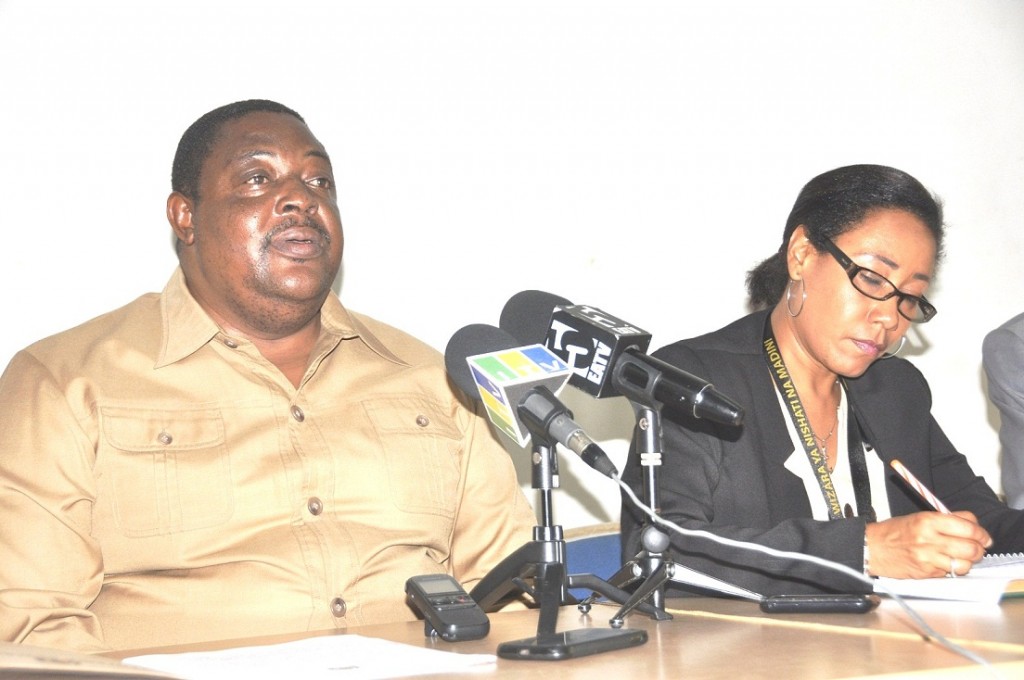Tanzania to upgrade mining cadastre information management system.

Tanzania Commissioner of Minerals Paul Masanja (L) During a Recent Press Conference (Internet File Photo)
By: Chantelle Kotze.
The Tanzania Ministry of Energy and Minerals, with funding from the World Bank’s International Development Asso-ciation, has launched a project to upgrade its Mining Cadastre Information Management System (MCIMS).
The upgrade, which is being undertaken by information technology company Spatial Dimension, will enable the existing MCIMS to support online transactions.
This will result in an integrated mining cadastre geoportal for all stakeholders in the mining sector, which will enable them to inter-act with the Ministry though modern Web-based technologies, apply for mining rights and maintain their existing mining rights, as well as submit reports and production returns electronically. Online payments, including the use of mobile phone-based money transfer such as M-Pesa, can also be made.
“In addition, the geoportal will provide access to the vast geodata repositories of the Ministry and the Geological Survey of Tanzania and, where appropriate, these datasets will be available for purchase and download.”
Spatial Dimension CEO Bill Feast says the Tanzania Ministry of Energy and Minerals manages one of the most complex mineral rights portfolios globally, with government offices around the country managing about 40,000 active mineral rights, owned by about 30,000 companies and individuals.
He adds that the Ministry has always considered ways through which it can leverage modern technology to manage the mining sector in a transparent and efficient manner. “This latest initiative will propel Tanzania to the global forefront of e-government initiative imple-mentation in the mining sector.” he says.
Tanzania’s Ministry of Energy and Minerals Commissioner for Minerals Paul Masanja says the transactional mining cadastre portal is “an important step” in the Ministry’s effort to enhance transparency and good governance in the minerals sector and to improve the management of mining licences in the country.
“The portal will serve people at the Ministry headquarters, in Dar es Salaam, at our 21 regional offices and at our four new regional offices that we expect to open in the next two years,” he says.
Spatial Dimension’s business relationship with the Ministry of Energy and Minerals goes back almost a decade, when the company first implemented its mining cadastre solution, FlexiCadastre, for the Ministry as part of a Nordic Development Fund project.
Since then, the Ministry has focused on optimising and improving the way in which it conducts business to not only manage existing mining and exploration activities effectively but also to generate responsible investments in the country.
“Since FlexiCadastre was first implemented in Tanzania, about 100,000 applications have been processed, resulting in more than 43,000 licences being granted,” Feast highlights.
He says a transactional online mining cadastre portal, with real-time access to geodata, will greatly improve investor confidence and interest in the mining sector in Tanzania, while also aligning itself with another ambitious World Bank initiative – the Billion Dollar Map Project for Africa.
This project aims to uncover the vast mineral wealth throughout Africa and enable better analysis of the costs and benefits of the mineral wealth, while promoting the standardis-ation and accessibility of geological information in Africa. Source: Mining Weekly



